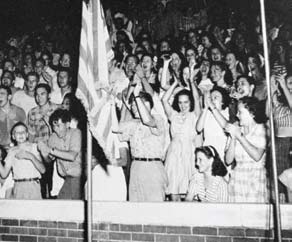|
A Centennial of Auburn Engineering:
|
||||||||
 |
| Cheering students gather in the football stadium to celebrate the end of the war. |
By 1950, Auburn began to resemble the pre-war period when young men and some young women dominated the college and the town. However, America was soon at war again and the graduation of World War II veterans, combined with the mobilization for the Korean War, meant fewer students. As registration for the fall quarter of 1952 began, it became apparent that enrollment would increase with returning Korean War veterans.
The Auburn Graduate Placement Service said that the average engineering graduate in June 1953 interviewed with “eight or ten companies . . . from all sections of the country.” However, while undergraduate engineering enrollment exploded, there were few graduate students in engineering because there was no money for research or fellowships and no member of the engineering faculty held a doctorate at that time.
Three years before Sputnik, as the Cold War heated up, a report from the National Research Council published in the Auburn Engineer said, “America is rapidly falling behind Russia in the race to produce engineers.” While 19,000 engineers graduated in the United States in 1954, the USSR graduated more than 50,000.
The fear of losing technological superiority to the Soviet Union continued as a theme in science and engineering circles but without state funding, Auburn’s engineering school fell further and further behind. Between 1951 and 1955, enrollment grew by 76 percent, but the dean was unable to add faculty.
In 1956, enrollment increased again and it was noted that “the pressures of enrollment have not been distributed equally among the schools, and most of the increase has been in the School of Engineering,” which grew by a factor of two and a half since 1951. This caused problems in obtaining qualified engineering faculty, equipment and supplies necessary to satisfy the rapid growth. With inadequate funding and increasing enrollment, the School of Engineering found itself in an untenable position. All of it came to a head with several significant events in 1957.
In October of that year, the Soviet Union launched Sputnik I, a small, unmanned satellite, which most Americans saw as a direct threat to national security. Then, just after Auburn won the Associated Press national football championship poll, the Engineers Council for Professional Development informed the institute that they “temporarily withdrew” accreditation for the electricaland mechanical engineering curricula, precipitating a crisis at Auburn.
 The action came about because teaching loads were “considered excessive” and faculty salaries“too low in the judgment of the council,” conditionswhich had existed since 1949. The national press howled at Auburn’s loss of engineering accreditation at a time when it won the national football championship and they accused API and the state of Alabama of having more interest in football than in academics.
What came to be Auburn’s “engineering crisis” led to soul searching and major changes at the School of Engineering –
changes that we will look at when we resume the final segment of the history of Auburn Engineering. It goes without saying that Auburn pulled itself up by its bootstraps.
The action came about because teaching loads were “considered excessive” and faculty salaries“too low in the judgment of the council,” conditionswhich had existed since 1949. The national press howled at Auburn’s loss of engineering accreditation at a time when it won the national football championship and they accused API and the state of Alabama of having more interest in football than in academics.
What came to be Auburn’s “engineering crisis” led to soul searching and major changes at the School of Engineering –
changes that we will look at when we resume the final segment of the history of Auburn Engineering. It goes without saying that Auburn pulled itself up by its bootstraps.
Administration, faculty, students and alumni did what it took to move back into accreditation as one of the most celebrated engineering programs in the Southeast and the nation. It is a story of guts and glory, of advances and retreats and amazing determination in the ebb and flow of recent history. Most of all, it is a story about the students who became the engineers that ushered the country into a newfound period of economic gain, space exploration and increased appreciation of the role of engineering in our society.
The next installment of “A Centennial of Auburn Engineering” will be featured in the fall/ winter 2011 issue of Auburn Engineering. We will continue to explore the evolution of the college and a number of its successes, as well as its challenges, which were met with an unyielding resolve to achieve progress.
This article has been adapted from chapters of a manuscript detailing the history of Auburn Engineering, from its founding in 1869 to its establishment as a college in 1909 and into the modern age of engineering that we know today.
Auburn alum Art Slotkin is a 1968 aerospace engineering graduate with a master’s in civil engineering and flight structures from Columbia University. After a diverse career, he retired from the computer services industry in 2003. He then attended Georgia Tech to obtain a master’s in sociology and history of technology and science. Slotkin has conducted much of the research for his book and this article in the Auburn University Library, Archives and Special Collections Department, with help from the university’s professional team of archivists. ![]()
Engineering E-Mag is a service of the Samuel Ginn College of Engineering. This newsletter is distributed to alumni and friends throughout the year.
To read archived copies visit: http://www.eng.auburn.edu/.
To learn more about the Samuel Ginn College of Engineering, visit our Web site at:http://www.eng.auburn.edu/.
QUESTIONS about Engineering E-Mag may be directed to Michael Stone, Webmaster for the Samuel Ginn College of Engineering, at webmaster@eng.auburn.edu
Auburn University is an equal opportunity educational institution/employer.


